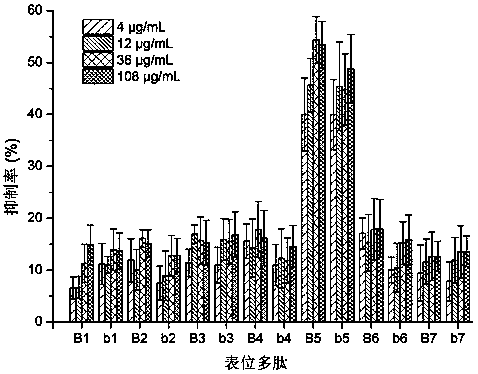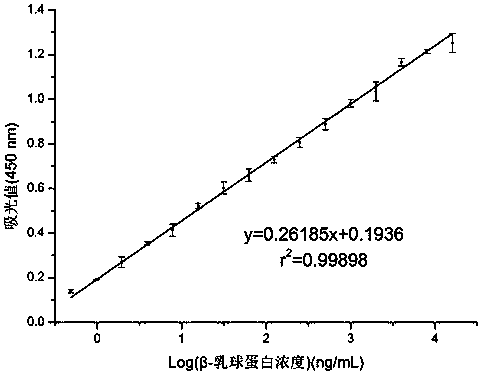A method for the detection of bovine milk β-lactoglobulin and its sensitizing residues based on nano-platinum probe
A lactoglobulin and probe detection technology, applied in the field of food analysis, to achieve the effect of wide linear range, high sensitivity and simple operation
- Summary
- Abstract
- Description
- Claims
- Application Information
AI Technical Summary
Problems solved by technology
Method used
Image
Examples
Embodiment 1
[0033] Example 1: Quantitative detection of the content of the allergen β-lactoglobulin in sunshine pure milk.
[0034] 1. Sample pretreatment.
[0035] Take 1 mL of sunshine pure milk at 10,000×g, centrifuge at 4 °C for 15 minutes to remove fat, and dilute the supernatant 10,000 times with blocking solution as a test sample.
[0036] 2. Sample testing.
[0037] (1) Coating: Dilute the tandem polyclonal antibody to 3.5 μg / mL with coating solution, add 100 μL to each well, and coat overnight at 4 °C.
[0038] (2) Washing: wash with PBST (containing 0.1% Tween-20) 3 times, each time for 3 min, and tap dry.
[0039] (3) Blocking: Use PBS with 2% gelatin (containing 0.1% Tween-20) blocking solution, add 250 μL to each well, and incubate at 37 °C for 0.5 h. After blocking, wash with PBST 3 times, each time for 3 min, and blot dry.
[0040] (4) Antigen addition: gradiently dilute the β-lactoglobulin standard in the range of 0.49–16,000 ng / mL with blocking solution, add 100 μL st...
Embodiment 2
[0047] Example 2: Quantitative detection of the content of β-lactoglobulin allergenic residues in partially hydrolyzed infant milk powder of Nestle Super Nen.
[0048] 1. Sample pretreatment.
[0049] Weigh 0.2 g of Nestle Super Nenen partially hydrolyzed infant milk powder, add blocking solution and fully dissolve to make the protein concentration 5 mg / mL. Centrifuge at 10,000×g at 4 °C for 15 minutes to remove fat and precipitates, and dilute the supernatant to 250 μg / mL, 50 μg / mL and 10 μg / mL with blocking solution, as test samples.
[0050] 2. Sample testing.
[0051] (1) Coating: Dilute the tandem polyclonal antibody to 3.5 μg / mL with coating solution, add 100 μL to each well, and coat overnight at 4 °C.
[0052] (2) Washing: wash with PBST (containing 0.1% Tween-20) 3 times, each time for 3 min, and tap dry.
[0053] (3) Blocking: Use PBS with 2% gelatin (containing 0.1% Tween-20) blocking solution, add 250 μL to each well, and incubate at 37 °C for 0.5 h. After bloc...
Embodiment 3
[0061] Example 3: Quantitative detection of β-lactoglobulin content in Milka Choco Break biscuits.
[0062] 1. Sample pretreatment.
[0063] Grind Milka Choco Break biscuits into powder, weigh 1.0 g of powder, add 20 mL of extraction solution (20 mmol / LTris-HCl, 2% Tween-20, pH 8.0), stir overnight at 4 °C to extract protein. The extract was centrifuged at 10,000 g at 4 °C for 15 min to remove fat and precipitates, and the supernatant was diluted 1,000 times with blocking solution as a test sample.
[0064] 2. Sample testing.
[0065] (1) Coating: Dilute the tandem polyclonal antibody to 3.5 μg / mL with coating solution, add 100 μL to each well, and coat overnight at 4 °C.
[0066] (2) Washing: wash with PBST (containing 0.1% Tween-20) 3 times, each time for 3 min, and tap dry.
[0067] (3) Blocking: Use PBS with 2% gelatin (containing 0.1% Tween-20) blocking solution, add 250 μL to each well, and incubate at 37 °C for 0.5 h. After blocking, wash with PBST 3 times, each tim...
PUM
 Login to View More
Login to View More Abstract
Description
Claims
Application Information
 Login to View More
Login to View More - R&D
- Intellectual Property
- Life Sciences
- Materials
- Tech Scout
- Unparalleled Data Quality
- Higher Quality Content
- 60% Fewer Hallucinations
Browse by: Latest US Patents, China's latest patents, Technical Efficacy Thesaurus, Application Domain, Technology Topic, Popular Technical Reports.
© 2025 PatSnap. All rights reserved.Legal|Privacy policy|Modern Slavery Act Transparency Statement|Sitemap|About US| Contact US: help@patsnap.com


